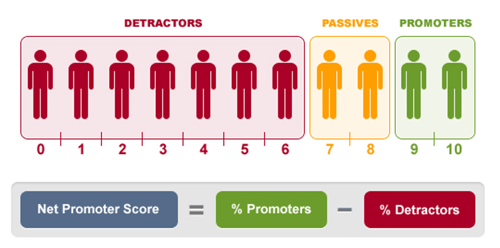To successfully grow your business, it is essential to gain a deep understanding of your customers, and their motivations for buying your products and services.
A lot of businesses talk about having a good NPS or wanting to improve their NPS. But what exactly is it; why should you care about it; and how do you go about measuring and improving it?
HOW DO YOU MEASURE CUSTOMER SATISFACTION?
NPS, which stands for Net Promoter Score, is a simple customer satisfaction (CSAT) metric, or more specifically, a customer loyalty metric. It gives a business an overall read on how satisfied their customers are by asking them how likely they would be to recommend the business to others.
Customers are asked one straightforward question to calculate the NPS:
“On a scale of zero to 10, how likely would you be to recommend our company or services?”
The percentage of customers giving a score of 0-6 (detractors – people who will not recommend your business to others and who might in fact recommend against using your business) is then subtracted from the percentage of customers giving a score of 9-10 (promoters – people who are very likely to recommend your business to others). Passives, those giving a score of 7-8 are not part of the calculation.
WHAT IS A GOOD CSAT SCORE?
A tricky question, but one frequently asked. Let’s start by looking at how an NPS scale works. It is a tough metric to score well on. The calculation is heavily weighted towards detractors giving them the whole range of points from 0-6. Passives are defined as a 7 or an 8, where in most other areas of life a score of 70% or 80% is considered pretty good. To even begin to get a positive NPS you need customers to give you a 9 or 10. And we know that some customers will just never give those scores even when they are actually very happy with your service or product. The way the metric is calculated is quite polarising.
In general, an NPS below 0 would be an indicator that your business has significant problems to address. Any NPS over zero can be seen as winning and 0-30 is a very respectable space to occupy. Scores of 30+ are considered a good customer satisfaction score and your business has far more satisfied customers than dissatisfied ones. If you are achieving scores of 70+ then your business is really acing its customer service, your customers love you and you are enjoying a high level of onward personal recommendations.
Another huge variable affecting what is considered a good NPS, is which industry or sector your business fits into. Some sectors such as hospitality, department stores and travel/leisure tend to achieve a higher NPS because customers like interacting with these companies and there are more opportunities to receive good customer service or enjoy innovative experiences. Typically, more essential, everyday sectors such as financial services, utility companies, internet providers often have a lower NPS.
There are numerous other factors affecting the average NPS between sectors, such as size of company (bigger companies attract more complaints and may collect data from a broader geographic area); level of competition and innovation and how that affects customer service perceptions; differing customer expectations; and whether a company is a start-up or an established player in its field.
SO WHY MEASURE CUSTOMER SATISFACTION?
Good question. It is difficult to obtain much insight from looking at your absolute NPS, lumped in with all sectors and industries that collate such a measure. However, it is a useful metric when looking at your own business’s customer satisfaction performance over time, and across different touchpoints; or if you want to benchmark your performance within your own industry, or your niche within that industry.
Understanding how your business is performing at an overall level within its competitive set is vital to maintaining or increasing market share, remaining relevant to your customers and achieving business growth and longevity.
Tracking the average NPS of your own business over time provides a handy barometer of customer satisfaction and loyalty. It can be used to motivate and reward staff and is a simple metric which can be shared with internal stakeholders or feed into board level KPIs.
Asking the NPS question at different moments during your customer’s journey with your business can also be revealing. For example, if you run a furniture retail company and asked your customers for their ‘likelihood to recommend’ score as they exit the store, they might on average give you a 9 out of 10. Let’s assume they enjoyed browsing the store, were helped by a friendly and knowledgeable member of staff, had a delicious coffee and cake in the café, and found the product they wanted to order. Let’s then imagine it is six weeks later, they have had no communication from the furniture company, and they still don’t know when their sofa is going to be delivered. Or perhaps the agreed delivery took place but the delivery men were rude and damaged a wall whilst putting the sofa into position. You can see that the customer satisfaction scores collected at those different moments might vary wildly.
It is therefore important to think about how you collate, group and analyse the scores you collect from your customers. Putting all scores into one pot still has value as it increases the sample size (and therefore the validity/robustness of the data) and is still a measure of overall satisfaction with your business and its customer touchpoints. It may not, however, tell you anything specific about which part of the customer journey is negatively impacting the NPS or how to fix it.
AND HOW DO YOU IMPROVE CUSTOMER SATISFACTION?
I would question whether improving your NPS is a sensible objective, when used in isolation. Instead, what a business should focus on is improving its customer service and consistently delivering a quality customer experience. If you do that then the NPS will go up.
To achieve that, the NPS question is often combined with a follow-up open-ended question along the lines of
“Please can you tell me why you gave that score?”
This seemingly innocuous question is where the magic happens.
The insights and context gathered at this point in the survey show you what you need to improve or change, and which changes to prioritise. The comments given by the Passives (those scoring 7 or 8) can be particularly enlightening as that group of customers are the least likely to give you spontaneous feedback via platforms such as Feefo or TrustPilot. Their experience was just a bit “meh”. Open-ended feedback collected within an NPS or a broader Customer Satisfaction survey, and then acted upon, will help turn “meh” into “amazing”.
The insights gathered can be coded and themed to shine a light on frequently occurring issues or pain points as well as providing granular detail for those businesses who want to follow up individual pieces of feedback.
To find out more about how we collect and analyse your customers’ feedback to provide actionable insights for your business, please contact me, Gina Mayhead, Head of Insight Services at Yomdel.








